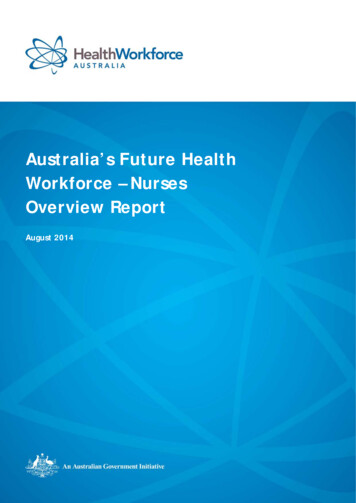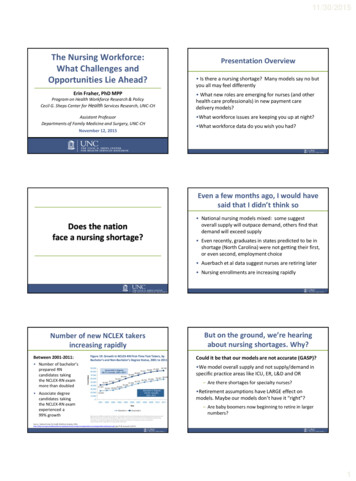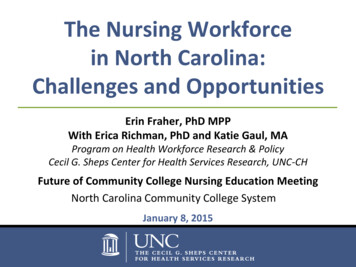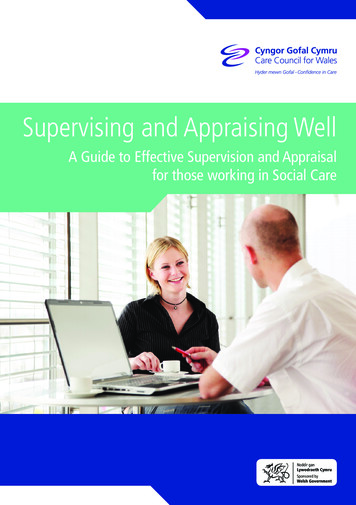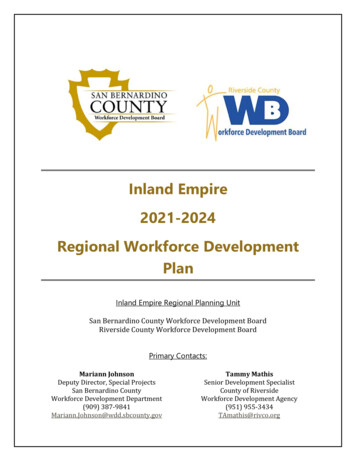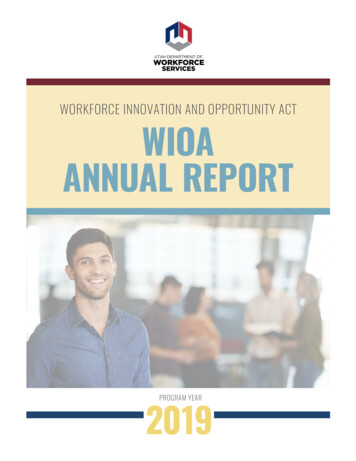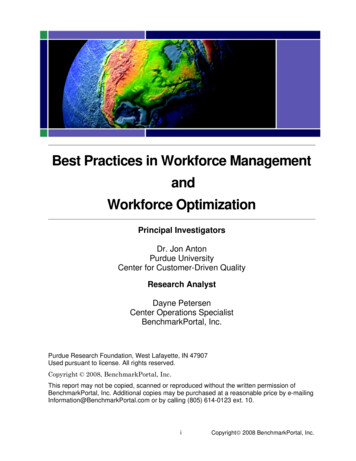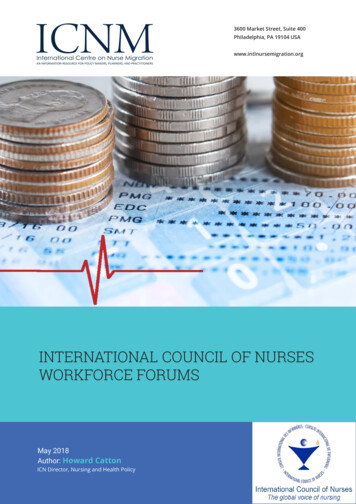
Transcription
3600 Market Street, Suite 400Philadelphia, PA 19104 USAwww.intlnursemigration.orgINTERNATIONAL COUNCIL OF NURSESWORKFORCE FORUMSMay 2018Author: Howard CattonICN Director, Nursing and Health Policy
CONTENTINTRODUCTION3BACKGROUND4METHODS5SALARY DATA & COMPARISON6FINDINGS7DISCUSSION12CONCLUSION14Web design & development for Company Name2
INTRODUCTIONFor more than 15 years, ICN has been hosting annual meetings ofNational Nursing Associations (NNAs) to specifically discuss key issuesand developments in relation to nurses’ working environments andemployment conditions, including pay and reward strategies. Whilstdata on the nursing labour market is collected and reported by the WHOGlobal Health Observatory, OECD and World Bank, there is little detailedinformation on nurses’ pay and conditions and a paucity of comparableanalysis. The ICN Workforce Forums are also a source of data, however,the workforce information that has been collected through these groupsover a 10 year period (2006-2016) has not previously been examined.This is the first historical analysis of the salary data that ICN hascollected through our National Nursing Associations. There areacknowledged caveats and limitations in terms of both the collection ofdata and conclusions that can be drawn. However, the findings stronglysuggest that many nurses have experienced a real terms’ fall in theirpurchasing power over recent years and that pay is not being used as asignificant lever to improve the recruitment of nurses.3
BACKGROUNDThere are two separate ICN Workforce Forums (the International andthe Asia Forum) that have each met annually. Actual country and NNAattendance and membership of each has changed on a meeting bymeeting basis.The NNAs that have attended the Asia or International Forums includeICN members from Australia, Canada, Denmark, Hong Kong, Indonesia,Ireland, Japan, Korea, Macau, Malaysia, New Zealand, Philippines,Singapore, Sweden, Taiwan, Thailand, the UK and the USA. In total, theForums cover a population of approximately nine million nurses.In preparation for each Forum meeting, participating NNAs haveprepared country reports providing an overview of the profile of theirnursing workforce, some labour market indicators (e.g. turnover), currentpay data and key workforce developments for each country using astandard data gathering template.The information collected has included starting salaries for hospitaland community-based Registered Nurses (RNs) and ward/unitnurse managers; wage trends with other comparable public-sectorprofessionals; the size of the nursing population; nurse unemploymentand nurse turnover rates.Using this data, ICN has for the first time undertaken an analysis of keytrends and developments for the 10-year period between 2006 and 2016.Because NNA attendance at the Forums has varied, the results presentedhere only includes those countries that have consistently provided dataover this period.Web design & development for Company Name4
METHODSA standard data collection template has been used for both WorkforceForums. NNAs self-report for the preceding year and use officialsources of labour market information that exist in their country as wellas information on pay and conditions arising from negotiations. Payinformation is based on gross salary before deductions, such as tax andpension contributions, and excludes allowances or bonuses covering, forexample, unsocial hours payments.The information provided to ICN by the NNAs has been summarized overa 10 year time frame and the data has been rechecked with the NNAs.ICN has not verified the data against the original country data source.Preliminary results have been tested and discussed with the NNAsattending the International and Asia Forums in 2017. It should be notedthat some of the country wage data has been aggregated based on subnational and regional mechanisms for wage determination and some paydeals are multi year.5
SALARY DATA &COMPARISONSalary information can be compared based on actual salaries andpercentage increases in the national currency, but this does not accountfor differences in the cost of living between different economies andregions.For this reason, the ICN analysis of salary data is presented inPurchasing Power Parity, or PPP, as defined by the International MonetaryFund (IMF). A PPP exchange rate equalizes the purchasing power ofdifferent currencies in their home countries for a given basket of goodsand this standardization facilitates an international comparison. The PPPis expressed in USD.The basket of consumer goods contains a number of the mostcommonly bought food and household items, e.g. personal goods andservices, housing and leisure costs, etc.These exchange rate comparisons can then be used to compare thestandards of living for defined populations in two or more countries. Inother words, nurses in two different countries that earned the same levelof PPP should have similar levels of purchasing power.This type of adjustment is dependent on finding a comparable basket ofgoods to compare purchasing power across countries, but it is generallyconsidered a more stable measure to use over time than market rateswhich can be volatile. PPP is not a perfect measure but is generallyregarded as the best available measure of overall income.Web design & development for Company Name6
FINDINGSThe average starting salary of hospital and community RegisteredNurses between 2006-16 for those countries whose NNAs attendedthe International Workforce Forum (IWWF) are presented in graph 1.Graph 1: Registered Nurse (RN) average starting salary Hospitaland Community, 2006-2016, PPP, IWFFA fall in average salary can be seen for both hospital and communitynurses in 2007/08 followed by a flat period until 2009/10 when there isan increase back to the 2007 level. That is followed by a further flatlineperiod virtually identical for hospital and community RNs but withevidence of an increase from 2014.7
The initial fall in starting salaries coincides with the beginning of theglobal economic crisis and the flat period continues during those yearswhere austerity measures were being followed in many countries aroundthe world.Since 2006, starting salaries appear not to have kept pace with cost ofliving, resulting in an overall reduction in nurses’ purchasing power.Graph 2 contains the average starting salary of hospital and communityRegistered Nurses between 2006-16 for those countries whose NNAsattended the Asia Workforce Forum (AWFF).Graph 2: Registered Nurse (RN) average starting salary Hospital &Community, 2006-2016, PPP, AWFFA fall in starting salaries can also be seen in the Asian countries in2007/08. However, that is followed by small increases and then adecrease; though, again, the position in 2013 has only returned tobroadly where it was in 2007.There appears to be a more noticeable increase for hospital staff in2014/15; however, there is evidence of a drop off again in 2016.Web design & development for Company Name8
In Graphs 3 and 4, the average starting salaries for RNs is broken downon a country basis for the International (graph 3) and Asia (graph 4)Forums.Graph 3: Registered Nurse (RN) starting salaries for RNs working inPublic Sector Hospitals, 2006-2016, PPP, IWFFThe broadly flat period between 2007/09 is evident followed by a smallincrease in 2010 and then flat again through until 2014.The three European countries have a similar and pronounced flat linebetween 2011/13. The US & Canada have two similar flat line periodsbetween 2007/09 and 2012/14.In graph 1, representing the average of starting salaries, there is anoticeable average increase from 2014 however the country breakdownsuggests that this is accounted for by a limited number of countries.9
Graph 4: Registered Nurse (RN) starting salaries for RNs working inPublic Sector Hospitals, 2006-2016, AWFFFor the Asian countries, the increase in starting salaries appears to startslightly earlier in 2013; however, for 2015/16, there is a suggestion ofboth stagnation and decline.NNAs have also provided data comparing the starting salaries of RNswith other professions in their country. Giving the RN the value of 1,NNAs report the starting salary of other professions in comparison tothat. That information is provided in Graph 5 and 6 again for both theInternational and Asia Forums.Graph 5: Average comparative salaries per profession, 2006-2016, IWFFWeb design & development for Company Name10
There has been fluctuation over the 10-year period however starting salarydifferentials are broadly the same in 2016 when compared to 2006.Physicians though appear to have maintained and, in more recent years,increased the differential in their starting salary compared to nurses andother professions.Graph 6: Average comparative starting salaries per profession,2006-2016, AWFFIn the Asian region, physicians again appear to have maintained and,in the last two years, increased the differential in their starting salarycompared to RNs and other professions.Each year, NNAs also report their nurse turnover rates as a percentageof those that annually leave the workforce.For the International WFF, the range for 2006 -07 was 5% -12%. For2015-16, the range was 8%-20%.For the Asia WFF, the range for 2006-07 was 2%-12%. For 2015-16, therange was 5%-15%.11
DISCUSSIONThere are limitations to the data that ICN has collected and these areacknowledged in the findings and should also be considered in theinterpretation of the results. However, across both Forums significantperiods of minimal pay growth can clearly be seen. This coincides withthe beginning of the global economic crisis in 2007/08 and has continueduntil 2014; a consequence of which has been that many nurses around theworld have experienced a real terms’ fall in their purchasing power over thepast 10 years.Whilst there is evidence of a pick-up in pay in the last two years, thisappears to be driven by a limited number of countries, rather than beinga trend across the board. In addition, particularly in Asia, there is alsoevidence of stagnation and another decline in pay in the last two years.Over the same period, turnover rates appear to have increased. In part, thismay be the result of the general ageing of the nursing workforce; however,ICN has continued to receive reports from NNAs that both the intensity ofwork and poor working conditions are resulting in some nurses makingdecisions to retire early or leave the profession.These trends are set against the backdrop of a global shortage of mursesand the recent UN High Level Commission on Health Employment andEconomic Growth estimating that this equates to approximately 9 millionnurses.Web design & development for Company Name12
Despite the current and predicted shortage, it appears that pay is not beingused as a lever to improve either the recruitment or retention of nurses.For some countries, this is presented as an affordability issue and themacroeconomic priority is to reduce debt with investment in nursing beingdependent on the return of economic growth and prosperity. However,during this period, physicians appear to have been insulated against payrestraint and in some countries have increased their pay differential withother professional groups. Even with the return of economic growth, payincreases are limited and, in some countries, appear to have stagnated andeven fallen back again. There is no evidence that the real terms decreasein purchasing power that nurses have experienced over the last 10 years isbeing consistently addressed.However, nurses are not immune from economic conditions that impacton their daily lives and will make choices based on their current and futureeconomic prospects. Therefore, decisions of potential nurses to enter theprofession will in part be based on the starting salary and the prospects ofreasonable career and pay progression. In addition, differences in pay andbenefits between countries appear to be a significant factor influencingmigration flows. The extent to which migration patterns are from relativelow to high pay countries is worthy of further research in the context ofthe current mismatch between nursing supply and country and populationdemands.13
CONCLUSIONSPolitical choices and priorities appear to be a dominate driver in termsof the level of nurses pay. However, politicians and policy makers cannotignore the significance of pay as a factor influencing the recruitment andretention of nurses.The recent UN Commission made the case for investment in healthservices as a pre-requisite for economic prosperity rather than a drag ongrowth and identified the scale of the needs-based shortage for nursesworldwide. In addition, global health priorities such as Universal HealthCoverage and NCDs are absolutely dependent on having sufficient numbersof skilled nurses and healthcare workers.Given the relative fall in nurses’ purchasing power over the last 10 years,there is an urgent need to give the world’s nurses a pay rise and betterworking conditions in order to address the attractiveness of the profession.In addition, short term decision making in relation to pay appears to beself-defeating. Medium and long term pay and reward strategies need to bein place to ensure workforce supply meets population needs and to delivereconomic competitiveness and sustainable growth.All governments have a responsibility to ensure the safety and security oftheir citizens and this includes having a sufficient number of healthcareprofessionals, because the consequences of not are detrimental to humanhealth and mortality.The recent launch of the Nursing Now global campaign provides agenerational opportunity to raise awareness of the value and contribution ofnurses and to make the case for positive political choices and investment.This should include significant improvements in nurses’ pay and workingconditions around the world.Web design & development for Company Name14
THANK YOUA special thank you to Lisa Little RN, BNSc, MHS, CEO,Lisa Little Consulting and ICN Board Member,Professor James Buchan PhD, DPM, MA(hons),Adjunct Professor, University of Technology, Sydneyfor consulatutheir reviewon thedevelopmentBrute epicureivelandno, adviceid pro vitaeoratiocausae. of this paper,Cu est latine numquam singulis, vis quasandvoluptaria te, exmea mundi vocent NursingTeam Coordinatoraliquam sensibus ne eum,ad labore timeampercipitur.for proher assistancewith dataanalysis.acilisis, mei nulla essent at. NoSit in populo nostrum fAbout ICNThe International Council of Nurses (ICN) is a federation of more than 130 nationalnurses associations (NNAs), representing the more than 20 million nursesworldwide. Founded in 1899, ICN is the world’s first and widest reachinginternational organisation for health professionals. Operated by nurses and leadingnurses internationally, ICN works to ensure quality nursing care for all, soundhealth policies globally, the advancement of nursing knowledge, and the presenceworldwide of a respected nursing profession and a competent and satisfied nursingworkforce.About ICNMThe International Centre on Nurse Migration (ICNM) serves as a comprehensiveknowledge resource created by the Commission on Graduates of ForeignNursing Schools (CGFNS) International in partnership with the InternationalCouncil of Nurses (ICN). ICNM emphasizes the development, promotion, anddissemination of research, policy, and information on global nurse migration.This resource center features news, resources, and publications widely availableto policy makers, planners, and intlnursemigration.org
The average starting salary of hospital and community Registered . slightly earlier in 2013; however, for 2015/16, there is a suggestion of both stagnation and decline. . increased the differential in their starting salary compared to nurses and other professions. Graph 6: Average comparative starting salaries per profession,



